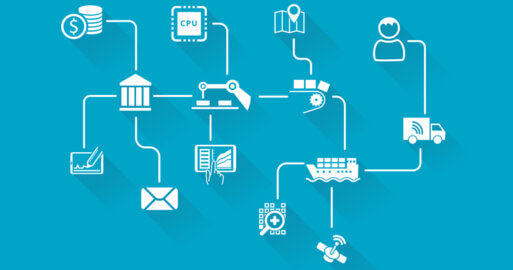Digital Darwinism Part 2: Digital Transformation is Key to Survival

Digital Darwinism has changed the way we communicate, socialize, shop and experience life. In Digital Darwinism Part 1: Disruptive Innovations Drive Digital Transformation, we examined why companies must adapt to disruptive innovations with digital transformation.
In Part 2, we’ll explore how digital Darwinism is changing the way companies do business and how companies can survive with digital transformation.
Examples of digital Darwinism for the future
What will the future look like? Here are a few examples of recent innovations in technology that are disrupting business models, strategies and the future of the digital economy.
Digital Darwinism is accelerating the speed of business
3D printing technology is disrupting the logistics industry by rapidly changing how, where and when products are designed, constructed and manufactured[1]. For example, when spare parts or products are printed on site, storage and transportation are no longer necessary. 3D printing is also gaining traction in the automotive and healthcare industries, as the Internet of Things (IoT) is capable of connecting big data analytics to 3D printing services through embedded sensors.
The two technologies combined, IoT and 3D printing, are ushering in a whole new set of disruptive innovations that are changing economic, social and cultural conditions worldwide. “Combining the two revolutions – digital manufacturing and big data – is starting to equip a multitude of industries with tools that can revolutionize the way processes are monitored, analyzed, and improved to enhance the quality of products.”[2]
Digital Darwinism is creating a sharing economy
What is a sharing economy? It may sound like a new phenomenon, but only the digital aspect is new. A sharing economy is an economic model in which resources are shared. Early hunter-gatherer societies shared food and shelter resources; they depended on social cooperation to ensure survival[3].
The Internet, a disruptive innovation in its own right, has accelerated the momentum of the digital sharing economy, enabling humans to share resources instead of owning them. For example, ride‑sharing is a cheaper alternative to car‑buying, plus it helps the environment by releasing fewer greenhouse gas emissions. With home sharing services like Airbnb and car sharing services like Uber, the global sharing economy market value is expected to reach 1.5 trillion USD by 2024[4].
Digital Darwinism is revolutionizing financial services
Many traditional financial services will change radically in the coming years, because changing global markets are increasing the demand for new real-time payment services. The ongoing digitalization of the financial services industry brings numerous disruptive technical innovations, such as blockchain, to the financial world that are fundamentally challenging previous processes and business models. Furthermore, customers are increasingly demanding new digital services, such as:
- Online banking and loans
- Mobile wallets
- Instant money transfers with digital services like MoneyGram
- Pay-As-You-Go (PAYG)
These customer demands are the direct nucleus for start-ups that want to conquer the market through digital technologies, and they are leading to a revolution in the financial sector.
How can companies survive digital Darwinism?
The accelerating adoption of digital technology is a challenge for traditional business models. In order to survive in the age of digital Darwinism, companies must embark on a journey of digital transformation and embrace new technologies into their business strategies.
The cloud is one example of a disruptive digital innovation that companies must incorporate into their business strategies, similarly to the way in which the publishing industry embraced the printing press.
Amazon is a prime example of a company that adapted quickly to evolving technology with digital initiatives. First, Amazon permanently changed the book market by shifting demand from paper books to e-books. Second, the company created a digital marketplace that other businesses depend upon for survival. Third, Amazon seized the opportunity to innovate with budding cloud technology and became the hosting leader with its cloud computing platform, Amazon Web Services (AWS). Not only has Amazon conquered enterprise cloud adoption with 80% of the market[5], AWS is the company’s primary profit driver[6], proving that Amazon is an undeniable leader in the age of digital Darwinism, disrupting and leading industries—first publishing and now the cloud.
Why is digital transformation necessary for survival?
Digital transformation has become the essential survival strategy for business, because digital technology impacts every aspect of business—from customers to employees. Companies must embrace new digital technologies in order to compete for customer loyalty in the marketplace. For example, using technology to gain valuable big data‑driven insights, such as where customers are shopping and what they are buying, can give companies a competitive advantage. Advances in technology, from email to virtual private networks (VPNs) and video conferencing, also enable employees to work productively from remote locations.
Cloud computing is an essential part of every digital transformation strategy for staying ahead of the competition, accelerating growth, increasing agility and driving innovation while keeping costs down. As companies use more cloud solutions, their cloud solutions must be technically and strategically integrated with each other and with existing systems. Deploying a hybrid integration platform like the SEEBURGER Business Integration Suite (BIS) is one strategy for seamless cloud integration between on‑premise and public cloud applications. Whether on-premises, in the SEEBURGER cloud or in public cloud environments such as AWS, BIS customers can determine their optimum operating model.
Companies that transform their operations through digital and cloud initiatives are better prepared to cushion the shocks from supply chain disruptions, labor shortages and other global calamities. Overall, digital preparedness enables business continuity and resilience.
Accelerate digital transformation with integration
Digitalization is the basis of a new industrial revolution that is creating winners and losers faster than ever before in human history. The engine for rapid digitalization is the power of innovation, and data is the oil. Google, Apple, Facebook and, of course, Amazon became giants of the modern digital age, because they created disruptive technological innovations that drove other businesses to digitally transform their operations in order to survive.
Companies that quickly adapt to disruptive innovations and evolving technologies can survive the competitive digital economy with digital transformation. Integration accelerates digital transformation by connecting clouds, applications and people. This results in business agility – a survival skill required for competing in today’s rapidly changing technology environment. Indeed, if digital discoveries can revive the dodo[7], then today’s businesses can embrace digital transformation to become stronger than ever.
Have you ever wondered why some businesses thrive while others fade into extinction? Stay tuned for Part 3 of our Digital Darwinism blog series, in which we’ll explore the common inhibitors for disruptive innovations – technophobia and scepticism.
Connect. Integrate. Accelerate.
SEEBURGER provides a future-ready agile infrastructure for digital transformation. Our solutions and technology can accelerate the digital transformation of your business.
[1] https://supplychaindigital.com/logistics/dhl-how-3d-printing-disrupting-logistics-industry
[2] IoT and 3D Printing – A creative manufacturing revolution – Business (ipsnews.net)
[3] Hunter-Gatherers & the Dawn of Agriculture (overstoryalliance.org)
[4] Shared Economy: WeWork, Uber, AirBandB, Lift (bccresearch.com)
[5] How Many Companies Use Cloud Computing in 2022? All You Need To Know (techjury.net)
[6] What Is Amazon Web Services and Why Is It So Successful? (investopedia.com)
[7] Dodo DNA discovery could lead to revival of extinct bird (nypost.com)
Thank you for your message
We appreciate your interest in SEEBURGER
Get in contact with us:
Please enter details about your project in the message section so we can direct your inquiry to the right consultant.
Written by: Rolf Holicki
Rolf Holicki, Director BU E-Invoicing, SAP&Web Process, is responsible for the SAP/WEB applications and digitization expert. He has more than 25 years of experience in e-invoicing, SAP, Workflow and business process automation. Rolf Holicki has been with SEEBURGER since 2005.





